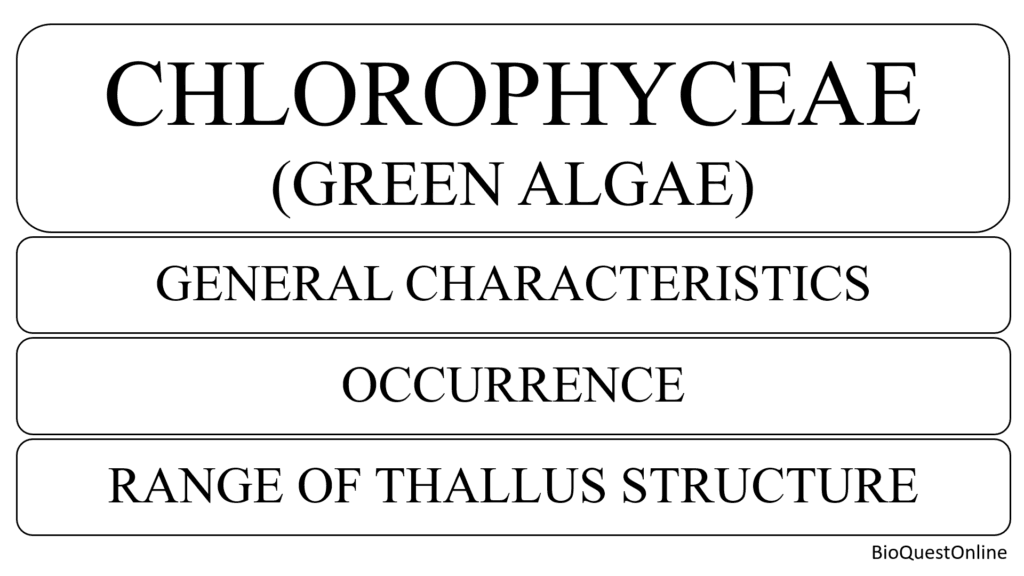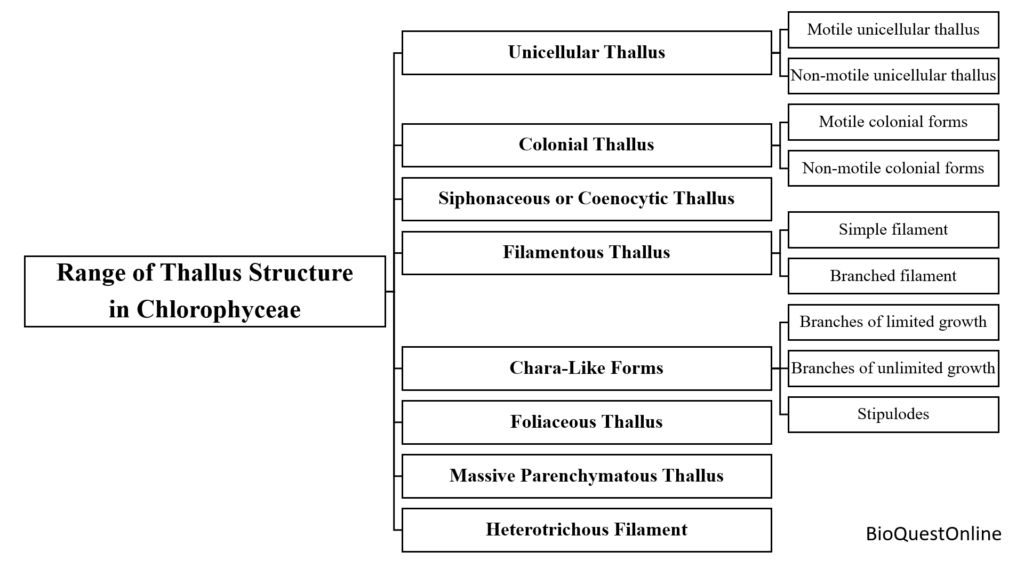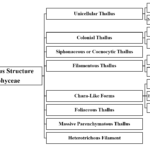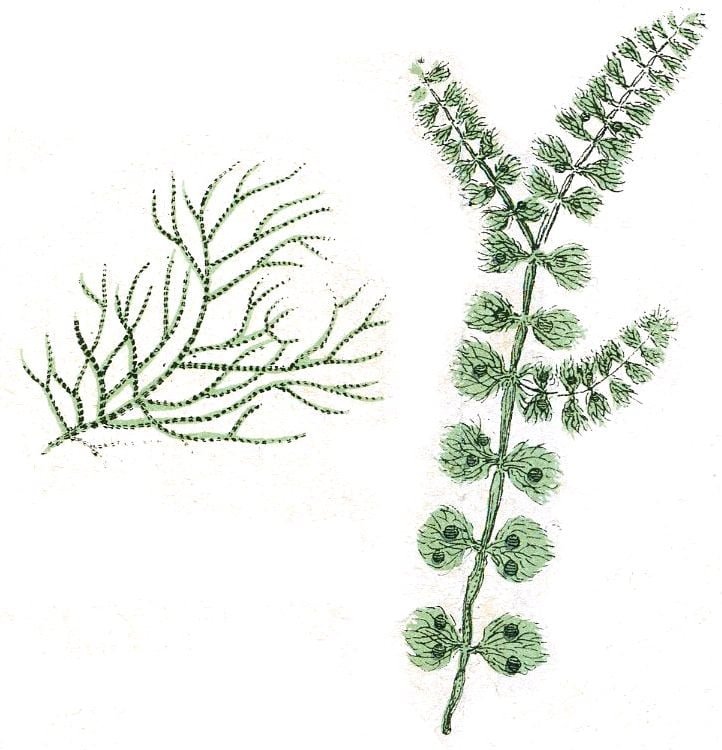Chlorophyceae, commonly referred to as “green algae.” Fritsch (1935) classified green algae under the class Chlorophyceae. However, it was classified as Chlorophyta by Smith (1938), Tippo (1942), and Bold (1950) elevated it to the rank of division, naming it Chlorophyta.
Subsequently, Prescott (1969) and Round (1973) further elevated its rank to the phylum Chlorophyta. Papenfuss (1946) introduced the suffix “phyco” to the divisions of algae, renaming Chlorophyta as Chlorophycophyta, a nomenclature later adopted by Bold and Wynne (1978).
The class, Chlorophyceae includes approximately 425 genera and 6,500 species. However, Prescott (1969) estimated that the number of species might reach 20,000, with more being discovered continuously.
The term “green algae” reflects the dominance of pigments such as chlorophyll a and b, which overshadow carotenoids and xanthophylls. All members of this group are eukaryotes.
General Characteristics of Chlorophyceae
- Members of Chlorophyceae predominantly grow in freshwater, with some species found in brackish or saline water, and a few occupying terrestrial habitats.
- Chlorophyceae exhibit a wide variety of thallus structures, including unicellular motile forms (Chlamydomonas), unicellular non-motile forms (Chlorella), coenobial forms (Volvox), palmelloid forms (Tetraspora), dendroid forms (Ecballocystis), filamentous branched (Cladophora) and unbranched (Spirogyra) forms, heterotrichous forms (Coleochaete), siphonaceous forms (Vaucheria), and parenchymatous forms (Ulva).
- The flagella, which range from one to many, are equal in size and can be apically or sub-apically inserted. Under an electron microscope, the flagella exhibit a typical 9+2 microtubule arrangement.
- Green algae exhibit eukaryotic cell structure, usually containing a single nucleus. However, members of Siphonales and Cladophorales possess multiple nuclei in their coenocytic bodies. While most cells have one nucleolus per nucleus, multiple nucleoli are observed in members of Conjugales.
- The cell wall is primarily composed of cellulose, often with hydroxyproline glycosides, xylans, or mannans. In Chara, the cell wall is further encrusted with calcium and magnesium carbonate.
- Beneath the cell wall, a semipermeable cell membrane encloses the protoplast. The cytoplasm contains small vacuoles that push the nucleus and surrounding cytoplasm toward the cell periphery, forming a structure known as the primordial utricle.
- Flagellated cells possess an eye-spot or stigma, located at the anterior end and embedded within one side of the chloroplast.
- Pigments are housed within the chloroplast, which often contains pyrenoids. The dominant pigments are chlorophylls a and b, which overshadow α- and β-carotenes and xanthophylls. Phycobilins are absent.
- Starch, composed of amylose and amylopectin, serves as the primary reserve food material.
- Members of Chlorophyceae reproduce through vegetative (cell division and fragmentation), asexual (e.g., zoospores, aplanospores, akinetes), and sexual (ranging from isogamy to oogamy) methods. However, some members of Chlorococcales donot undergo sexual reproduction.
- In their life cycle, the zygote or oospore is the only diploid structure.

Occurrence of Chlorophyceae
- Members of Chlorophyceae primarily thrive in freshwater habitats (approximately 90%), with the remainder found in saline water, terrestrial environments, and other habitats. Freshwater species such as Volvox, Oedogonium, and Spirogyra commonly inhabit ponds, pools, and lakes.
- Certain groups in Chlorophyceae, like the Conjugales (e.g., Spirogyra, Zygnema) and Oedogoniales (e.g., Oedogonium), are strictly freshwater, whereas members of Ulvaceae and Siphonales are predominantly marine. Some species within the Volvocales, Chaetophorales, and Cladophorales can grow in both freshwater and saline water environments.
- Specific species of green algae, such as Ulothrix and Vaucheria, are subaerial and thrive on damp soil. Some of them are terrestrial epiphytes (e.g., Trentepohlia), epizoic (e.g., Characium and Cladophora), endophytic (e.g., Chlorella), and parasitic (e.g., Rhodochytrium, and Phyllosiphon).
- Additionally, green algae can adapt to diverse habitats, including hot springs (e.g., Chlorella), snow (e.g., Chlamydomonas yellowstonensis), saline water (e.g., Chlamydomonas ehrenbergi), and as symbiotic partners in lichen associations.
Range of Thallus Structure in Chlorophyceae
Chlorophyceae exhibit remarkable diversity in their vegetative structures, life cycles, and habitats, surpassing any other algal group. Thallus structure in green algae shows significant variation, ranging from simple and primitive motile unicellular forms to large, highly evolved multicellular forms.
The size of the thalli varies widely, from just a few microns to several feet in length. Among the green algae, the order Volvocales is considered the most primitive, with motile unicellular forms representing the simplest and most basic thallus structure.
The range of thallus structure in Chlorophyceae can be categorized as follows:
Unicellular Thallus
This is the simplest form of thallus organization in Chlorophyceae, consisting of a single cell, which can be either motile or non-motile.
- Motile unicellular thallus: These algae are unicellular, spherical or oval in shape, and possess flagella. Examples include Chlamydomonas and Haematococcus. Chlamydomonas is a motile unicellular algae which have almost spherical body and consist of two flagella at its anterior end.
- Non-motile unicellular thallus: These unicellular algae lack flagella, an eye spot, and a contractile vacuole. They are referred to as coccoid forms. Examples include Chlorella and Chlorococcum.

Colonial Thallus
When individual unicellular algae loosely adhere to each other, they form a colony. The cells in such a structure are simple and unspecialized. Colonial thalli can be either motile or non-motile.
- Motile colonial forms:
- These colonies are formed when a specific number of flagellated unicells come together, bound by mucilage, to create a motile colony.
- These colonies may consist of 4, 8, 16, or more flagellated cells. Each cell is physiologically independent and resembles Chlamydomonas, functioning as an individual unit.
- If the cells within the colony have a fixed number, arrangement, and show anterior-posterior polarity, the colony is referred to as a coenobium. Examples include Gonium, Volvox, and Pandorina.
- In Gonium, the colony contains only a few cells, and the only sign of organization is the coordinated beating of the flagella.
- Pandorina, which is similar in size to Gonium, shows more advanced characteristics due to the differentiation of cells between the anterior and posterior ends. Volvox forms a spherical coenobium visible to the naked eye, consisting of approximately 50,000 Chlamydomonas-like biflagellate cells.
- While Volvox is a multicellular colony, it is not considered a multicellular organism because the cells coordinate only for colony movement; they remain independent regarding nutrition, respiration, and other vital functions.
- Upon maturity, Volvox exhibits polarity, with about 95% of the cells resembling Chlamydomonas (located in the anterior part) and the remaining 10% being gonidial cells concentrated in the posterior region.
- Non-motile colonial forms:
- These colonies form when unicells either lose their flagella or never develop them, resulting in an immobile colony.
- An example is Hydrodictyon. A mature Hydrodictyon colony, also known as “water net,” consists of elongated cells joined at their ends to form polygonal shapes.
- These cells are coenocytic, containing multiple nuclei. The entire colony is a hollow cylinder that can grow up to 75 cm in length.
Siphonaceous or Coenocytic Thallus
In some Chlorophyceae, a single cell elongates to form a tubular or sac-like structure that is multinucleate and lacks septa. This condition, known as the coenocytic condition, arises from karyokinesis (nuclear division) without cytokinesis (cell division).
- Examples include Codium and Vaucheria. Vaucheria has a long, branched thallus that is coenocytic and siphonaceous. The thallus is aseptate, with septa forming only during reproduction or at sites of injury.
- Internally, it contains a siphon-like central vacuole, which is characteristic of the order Siphonales.
- Acetabularia is a siphonaceous alga consisting of a stalk that ends in an umbrella-shaped cap. The stalk contains the only nucleus in the thallus.
- Caulerpa, consist of large and branched coenocytic thallus, creeping and errect rhizome, varied shapes of assimilatory shoot.
Filamentous Thallus
This type of thallus in green algae forms when cells remain tightly bound by the middle lamella following multiple transverse divisions, resulting from the repeated division of a unicell in a single plane. If the cells of the filament divide longitudinally, branching occurs. Filamentous thalli can be classified into two main types:
- Simple filament:
- This type of thallus consists of a single, unbranched row of cells arranged in a straight line. In Spirogyra, the cells are arranged end to end in a single file, forming an unbranched filament, considered an advanced filamentous thallus.
- In Ulothrix, the cells are also arranged in a single row, similar to Spirogyra, but the thallus has a rhizoidal cell at one end for attachment to the substrate and an apical cell at the other end.
- In Oedogonium, the thallus is a long, unbranched filament exhibiting apical-basal polarity and division of labor among cells. It consist of rhizoidal cell for attachment, vegetative cells for photosynthesis, and antheridia and oogonia for reproduction.
- Branched filament:
- This type of thallus forms when certain cells in a filament divide longitudinally, resulting in lateral branches.
- In Cladophora, the branches arise as lateral outgrowths from the main axis, giving the thallus a bush-like appearance.
- The alga is attached to rocks by rhizoidal outgrowths at the base. Its individual cells are large, multinucleate, cylindrical, and arranged end to end.
- In the Aegagropila group, which grows in water, wave action causes young branches to aggregate, forming floating spherical structures.
Chara-Like Forms
These algae have a plant-like body with a structure resembling Equisetum, characterized by distinct nodes and internodes along the main axis. Three types of appendages arise from the nodes:
- Branches of limited growth:
- These branches, also known as primary laterals, leaves, or branchlets, arise in whorls of 6–16 at the nodes of the main axis and the branches of unlimited growth. They cease growth after a certain period and bear reproductive structures.
- Branches of unlimited growth:
- These branches emerge from the axils of the branches of limited growth. Like the main axis, they also possess nodes and internodes, as well as a whorl of primary laterals at each node. These branches continue growing indefinitely.
- Stipulodes:
- At the basal nodes of the branches of limited growth, unicellular outgrowths called stipulodes are formed. The main axis exhibits apical growth, and the plant is anchored to the substrate by a well-developed rhizoidal system.
Foliaceous Thallus
A membranous or foliaceous body forms when the cells of a filament divide in two planes—transversely and longitudinally. This results in a structure that resembles a green paper sheet, such as Ulva, which is commonly known as sea lettuce due to its leaf-like, lettuce-shaped appearance. The basal part of the thallus develops into a stalk.
Massive Parenchymatous Thallus
When cell divisions occur regularly in all three planes, a large, three-dimensional parenchymatous body is formed, such as in Enteromorpha.
Heterotrichous Filament
Heterotrichy refers to the presence of two types of branching: a prostrate system, which spreads along the substrate, and an erect system, which consists of upright branches.
- This is the most advanced and evolved type of thallus, found in the Chaetophorales. The prostrate system anchors the thallus to the substrate by sending out rhizoids, while the erect branches arise from the prostrate system.
- In some green algae, both the prostrate and erect systems are well-developed, as seen in Stigeoclonium and Fritschiella.
- In Coleochaete, the erect system is reduced to a few hairs, while in Chaetophora, the erect system is more pronounced.
- In Fritschiella, the prostrate system forms a rounded cluster of cells embedded in the mud, while the erect system consists of two parts: a lower primary system that projects outward and an upper secondary system.
- Through modifications of the heterotrichous habit, other thalli have evolved.
- In Draparnaldia, the prostrate system is reduced to a holdfast, and the erect system is differentiated into a main axis with lateral branches.
- In Draparnaldiopsis, the main branches alternate between short and long cells, and the nodes and internodes are present. The main axis serves as support, while the lateral branches are responsible for photosynthesis and reproduction.
FREQUENTLY ASKED QUESTIONS (FAQS)
Why is Chlorophyceae called green algae?
Chlorophyceae, commonly referred to as “green algae” due to dominance of pigments such as chlorophyll a and b, which overshadow carotenoids and xanthophylls.
What are 10 important characteristics of Chlorophyceae.
10 important characteristics of Chlorophyceae are as following:
1. Chlorophyceae inhabit freshwater, brackish/saline water, and some terrestrial areas.
2. Thallus forms include unicellular, filamentous, siphonaceous, and parenchymatous types.
3. Flagella have a 9+2 structure and are apically or sub-apically inserted.
4. Cells are eukaryotic, with single or multiple nuclei in coenocytic forms.
5. The cellulose-based cell wall may contain minerals like calcium carbonate.
6. A semipermeable membrane encloses the protoplast and forms a primordial utricle.
7. Flagellated cells have an eye-spot in the chloroplast.
8. Chloroplasts contain chlorophyll a and b but lack phycobilins.
9. Starch serves as the primary food reserve.
10. Reproduction occurs vegetatively, asexually, or sexually, with the zygote as the only diploid stage.
Where does Chlorophyceae occur?
Chlorophyceae primarily thrive in freshwater (e.g., Spirogyra, Oedogonium, Volvox) and are found in ponds, pools, and lakes, with some species like Ulvaceae and Siphonales being predominantly marine.
Some species (e.g., Ulothrix, Vaucheria) are subaerial and grow on damp soil, while others are epiphytic (e.g., Trentepohlia), epizoic (e.g., Characium), endophytic (e.g., Chlorella), or parasitic (e.g., Rhodochytrium).
Green algae inhabit extreme environments like hot springs (e.g., Chlorella), snow (e.g., Chlamydomonas yellowstonensis), saline water (e.g., Chlamydomonas ehrenbergi), and form lichen symbioses.
What is the range of thallus structure in Chlorophyceae?

Chlorophyceae exhibit diverse thallus structures, ranging from simple motile unicellular forms (e.g., Volvocales) to large, advanced multicellular forms, with thalli sizes varying from a few microns to several feet.
Unicellular Thallus: Simplest thallus type; includes motile forms like Chlamydomonas (flagellated) and non-motile forms like Chlorella (coccoid).
Colonial Thallus: Consists of loosely adhering unicells; motile colonies include Volvox, and non-motile ones include Hydrodictyon.
Siphonaceous Thallus: Coenocytic and tubular, e.g., Vaucheria (aseptate branches) and Caulerpa (large coenocytic body).
Filamentous Thallus: Includes unbranched forms like Spirogyra, branched forms like Cladophora, and heterotrichous types like Fritschiella (prostrate and erect systems).
Advanced Thallus Forms: Foliaceous (Ulva), parenchymatous (Enteromorpha), and Chara-like forms with nodes, internodes, and specialized branches.


